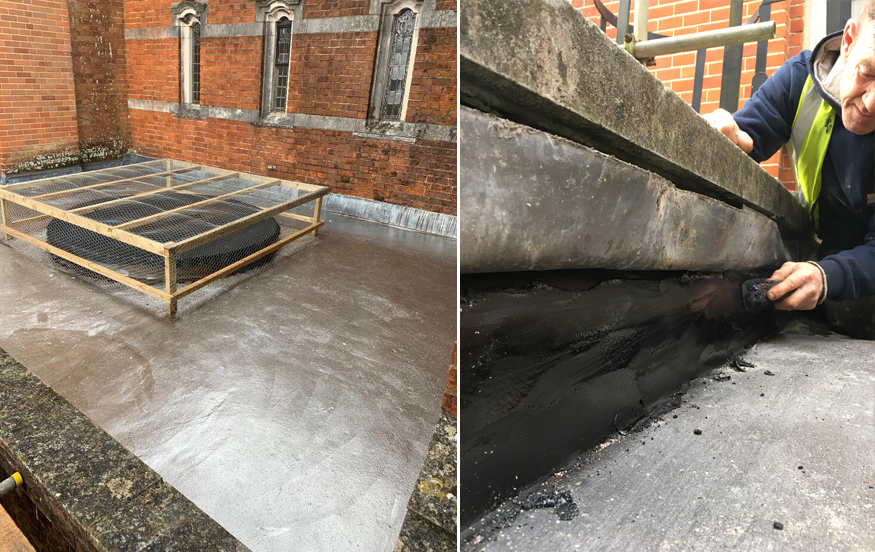Mastic asphalt is typically perceived as a one-dimensional, traditional roofing material that is black in appearance, but more and more Mastic Asphalt Council (MAC) contractor members are finding that clients are now seeking innovative uses for mastic asphalt that take it away from the norm.
One such example is a prestigious military establishment in Devon which dates back to 1863. Mastic asphalt had previously been chosen to waterproof several roofs at the Grade II military site, and it had provided between 50-100 years’ effective protection before requiring refurbishment. Due to its historic nature and grade listing, any refurbishment works needed to be undertaken sensitively to protect the original character of all structures.
Due to its longevity and durability, mastic asphalt was again chosen to refurbish the roof of the historic chapel at the military site. The chapel itself dates back to 1905 and was designed by Sir Aston Webb who was considered to be one of the Victorian period’s most talented and esteemed architects, having designed the principal façade of Buckingham Palace, Admiralty Arch and the front entrance of the Victoria and Albert Museum.
MAC member DFR Roofing was chosen to apply mastic asphalt to the 80m2 rectangular cathedral roof. The existing mastic asphalt had lasted well in excess of 50 years before requiring refurbishment and it was perceived that the replacement mastic asphalt would offer a comparable lifespan, if not more.
This project differed from many other mastic asphalt roofing applications as the client required the mastic asphalt to be overpainted with a metallic silver coating. This was largely to reflect the original materials and methods used in the historic build and to remain consistent with other surrounding mastic asphalt roofing areas, all of which were silver painted. This is a common feature in many military establishments across the UK.
Mastic asphalt traditionally consists of graded limestone aggregate bound together with bitumen, but for this project a more modern, advanced polymer modified mastic asphalt system was used as it ensures all the performance characteristics of traditional asphalt systems, with the added benefits of increased flexibility, enhanced handling and sustainability. Its low temperature flexibility ensures that the system can be installed in cold weather.
Mastic asphalt is one of the few construction activities still regarded as a ‘craft trade’. The skilled work involves ensuring that asphalt is at the correct temperature, and then spreading it using traditional techniques to coat the surface. A thermoplastic material that changes shape when heated, mastic asphalt cures to form a hard, durable, finished product to suit all applications of mastic asphalt.
To maintain the industry’s reputation and ensure high quality applications for every single project, only trained applicators are permitted to install mastic asphalt under the Mastic Asphalt Council’s (MAC) stringent rules. DFR Roofing’s operatives are experienced applicators who comply with MAC’s strict guidelines.
As with any military establishment, the site was subject to strict security procedures and protocols. The roofing area was also set back into the building, above an additional two roofing levels. Due to the height and position of the roofing area, the mastic asphalt required for the project needed to be transported to the cathedral roof using a mixture of manual handling and hoists. Despite the height of the building, the project area presented no major challenges and the mastic asphalt was applied to the cathedral roof with ease. Once the mastic asphalt was applied by DFR Roofing, it was overcoated with the metallic silver paint to achieve the effect the client was seeking.
The heritage market is a key sector for the industry and mastic asphalt is frequently specified by the National Trust and English Heritage, as well as other public and private owners of prestigious buildings for refurbishment projects. Buckingham Palace is testament to the longevity of mastic asphalt. On top of the Royal household is a rooftop of mastic asphalt that has kept the building dry for well over 80 years.
Other heritage applications include the Houses of Parliament, the Tower of London, Tower Bridge and Edinburgh Castle. Although mastic asphalt is a traditional material that was first patented in 1837 and has been around for years in more simple guises than today, it offers durability and wear resistance far beyond modern alternatives.
Fire safety was another key consideration for this project as the high mineral content of mastic asphalt renders it virtually incombustible. Mastic asphalt fulfils all the external fire resistance required for a roof covering and achieves the highest rating (AA) when tested in accordance with BS 476: Part 3. It has also been tested in accordance with draft European standards prEN1187-1 and prEN1187-2. No significant spread of flame was observed and no flame penetration occurred.
As mastic asphalt is laid in molten form, it is often confused with other types of waterproofing membrane that require naked flame or torch on application. In reality, there is no naked flame at the point of installation and because mastic asphalt is so highly flame resistant, there is little or no potential of fire risk.
Another advantage is the green credentials of mastic asphalt, as it is carbon neutral and when it has reached the end of its useful life, it can be recycled or used as roof screed. Ten years ago the mastic asphalt sector became the first industry in the world to achieve the CarbonZero standard.
This article featured within the May edition of RCi Magazine – click here to view the full article.

